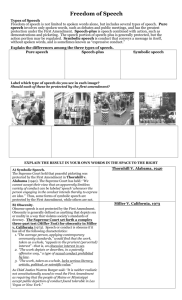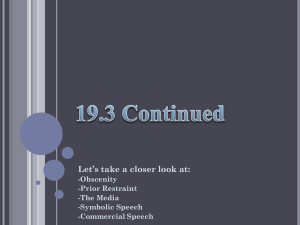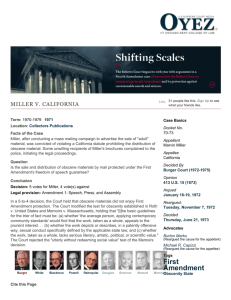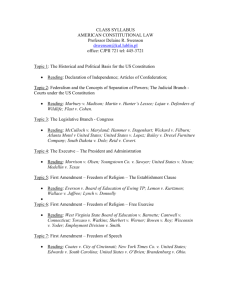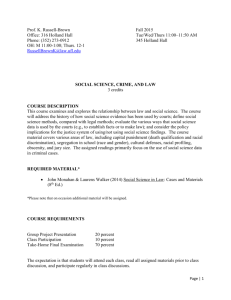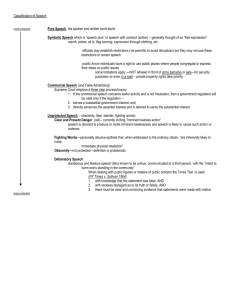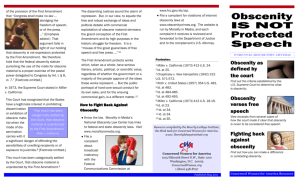Terminiello v - Kenston Local Schools
advertisement
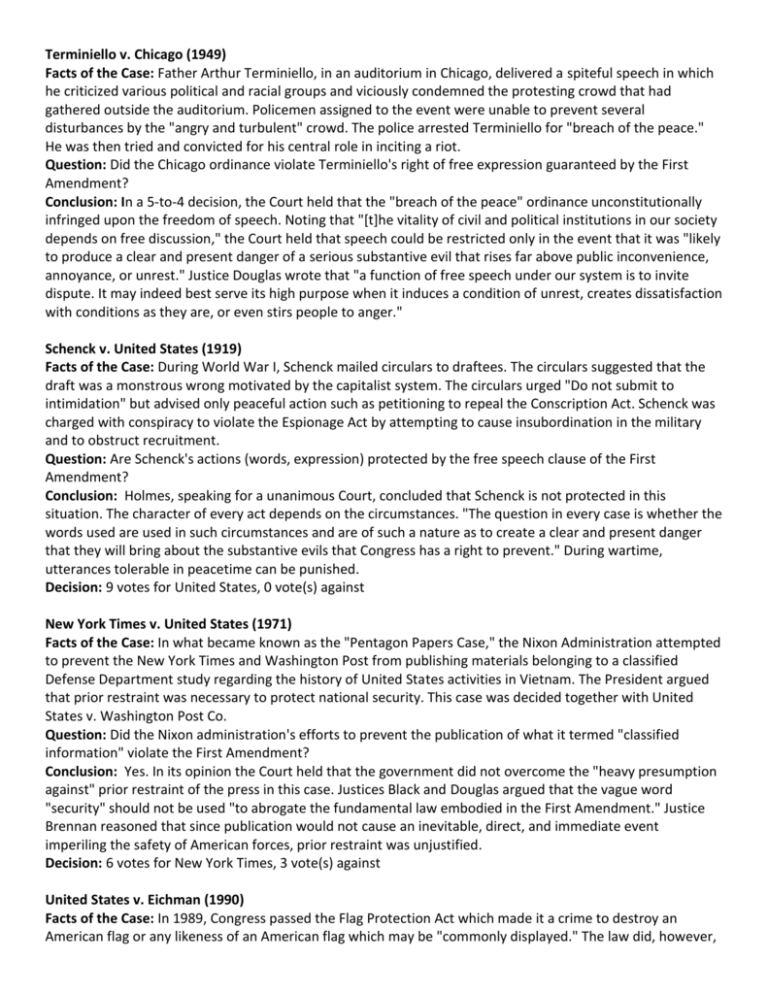
Terminiello v. Chicago (1949) Facts of the Case: Father Arthur Terminiello, in an auditorium in Chicago, delivered a spiteful speech in which he criticized various political and racial groups and viciously condemned the protesting crowd that had gathered outside the auditorium. Policemen assigned to the event were unable to prevent several disturbances by the "angry and turbulent" crowd. The police arrested Terminiello for "breach of the peace." He was then tried and convicted for his central role in inciting a riot. Question: Did the Chicago ordinance violate Terminiello's right of free expression guaranteed by the First Amendment? Conclusion: In a 5-to-4 decision, the Court held that the "breach of the peace" ordinance unconstitutionally infringed upon the freedom of speech. Noting that "[t]he vitality of civil and political institutions in our society depends on free discussion," the Court held that speech could be restricted only in the event that it was "likely to produce a clear and present danger of a serious substantive evil that rises far above public inconvenience, annoyance, or unrest." Justice Douglas wrote that "a function of free speech under our system is to invite dispute. It may indeed best serve its high purpose when it induces a condition of unrest, creates dissatisfaction with conditions as they are, or even stirs people to anger." Schenck v. United States (1919) Facts of the Case: During World War I, Schenck mailed circulars to draftees. The circulars suggested that the draft was a monstrous wrong motivated by the capitalist system. The circulars urged "Do not submit to intimidation" but advised only peaceful action such as petitioning to repeal the Conscription Act. Schenck was charged with conspiracy to violate the Espionage Act by attempting to cause insubordination in the military and to obstruct recruitment. Question: Are Schenck's actions (words, expression) protected by the free speech clause of the First Amendment? Conclusion: Holmes, speaking for a unanimous Court, concluded that Schenck is not protected in this situation. The character of every act depends on the circumstances. "The question in every case is whether the words used are used in such circumstances and are of such a nature as to create a clear and present danger that they will bring about the substantive evils that Congress has a right to prevent." During wartime, utterances tolerable in peacetime can be punished. Decision: 9 votes for United States, 0 vote(s) against New York Times v. United States (1971) Facts of the Case: In what became known as the "Pentagon Papers Case," the Nixon Administration attempted to prevent the New York Times and Washington Post from publishing materials belonging to a classified Defense Department study regarding the history of United States activities in Vietnam. The President argued that prior restraint was necessary to protect national security. This case was decided together with United States v. Washington Post Co. Question: Did the Nixon administration's efforts to prevent the publication of what it termed "classified information" violate the First Amendment? Conclusion: Yes. In its opinion the Court held that the government did not overcome the "heavy presumption against" prior restraint of the press in this case. Justices Black and Douglas argued that the vague word "security" should not be used "to abrogate the fundamental law embodied in the First Amendment." Justice Brennan reasoned that since publication would not cause an inevitable, direct, and immediate event imperiling the safety of American forces, prior restraint was unjustified. Decision: 6 votes for New York Times, 3 vote(s) against United States v. Eichman (1990) Facts of the Case: In 1989, Congress passed the Flag Protection Act which made it a crime to destroy an American flag or any likeness of an American flag which may be "commonly displayed." The law did, however, allow proper disposal of a worn or soiled flag. Several prosecutions resulted from the Act. Eichman set a flag ablaze on the steps of the U.S. Capitol while protesting the government's domestic and foreign policy. Another prosecution (United States v. Haggerty) resulted from a flag-burning in Seattle protesting the passage of the Flag Protection Act.Both cases (Eichman's and Haggerty's) were argued together. Question: Did the Act violate freedom of expression protected by the First Amendment? Conclusion: In a 5-to-4 decision, coming on the heels of a similar holding in Texas v. Johnson (1989), the Court struck down the law because "its asserted interest is related to the suppression of free expression and concerned with the content of such expression." Allowing the flag to be burned in a disposal ceremony but prohibiting protestors from setting it ablaze at a political protest made that clear, argued Justice Brennan in one of his final opinions. Hazelwood School District v. Kuhlmeier (1988) Facts of the Case: The Spectrum, the school-sponsored newspaper of Hazelwood East High School, was written and edited by students. In May 1983, Robert E. Reynolds, the school principal, received the pages proofs for the May 13 issue. Reynolds found two of the articles in the issue to be inappropriate, and ordered that the pages on which the articles appeared be withheld from publication. Cathy Kuhlmeier and two other former Hazelwood East students brought the case to court. Question: Did the principal's deletion of the articles violate the students' rights under the First Amendment? Conclusion: No. In a 5-to-3 decision, the Court held that the First Amendment did not require schools to affirmatively promote particular types of student speech. The Court held that schools must be able to set high standards for student speech disseminated under their auspices, and that schools retained the right to refuse to sponsor speech that was "inconsistent with 'the shared values of a civilized social order.'" Educators did not offend the First Amendment by exercising editorial control over the content of student speech so long as their actions were "reasonably related to legitimate pedagogical concerns." The actions of principal Reynolds, the Court held, met this test. Tinker v. Des Moines Ind. Comm. School Dist. (1969) Facts of the Case: John Tinker, his sister Mary Beth, and Christopher Echardt decided along with their parents to protest the Vietnam War by wearing black armbands to their Des Moines schools during the Christmas holiday season. Upon learning of their intentions, and fearing that the armbands would provoke disturbances, the principals of the Des Moines school district resolved that all students wearing armbands be asked to remove them or face suspension. When the Tinker siblings and Christopher wore their armbands to school, they were asked to remove them. When they refused, they were suspended until after New Year's Day. Question: Does a prohibition against the wearing of armbands in public school, as a form of symbolic protest, violate the First Amendment's freedom of speech protections? Conclusion: The wearing of armbands was "closely akin to 'pure speech'" and protected by the First Amendment. School environments imply limitations on free expression, but here the principals lacked justification for imposing any such limits.The principals had failed to show that the forbidden conduct would substantially interfere with appropriate school discipline. Decision: 7 votes for Tinker, 2 vote(s) against Chaplinsky v. New Hampshire (1942) Facts of the Case: Chaplinsky, a Jehovah's Witness, called a city marshal a "God-damned racketeer" and "a damned fascist" in a public place. He was arrested and convicted under a state law for violating a breach of the peace. Question: Does the application of the statute violate Chaplinsky's freedom of speech protected by the First Amendment? Conclusion: No. Some forms of expression--among them obscenity and fighting words--do not convey ideas and thus are not subject to First Amendment protection. In this case, Chaplinsky uttered fighting words, i.e., words that "inflict injury or tend to incite an immediate breach of the peace." Cantwell v. State of Connecticut (1940) Facts of the Case: Jesse Cantwell and his son were Jehovah's Witnesses; they were proselytizing a predominantly Catholic neighborhood in Connecticut. The Cantwells distributed religious materials by travelling door-to-door and by approaching people on the street. After voluntarily hearing an anti-Roman Catholic message on the Cantwells' portable phonograph, two pedestrians reacted angrily. The Cantwells were subsequently arrested for violating a local ordinance requiring a permit for solicitation and for inciting a breach of the peace. Question: Did the solicitation statute or the "breach of the peace" ordinance violate the Cantwells' First Amendment free speech or free exercise rights? Conclusion: Yes. In a unanimous decision, the Court held that while general regulations on solicitation were legitimate, restrictions based on religious grounds were not. Because the statute allowed local officials to determine which causes were religious and which ones were not, it violated the First and Fourteenth Amendments. The Court also held that while the maintenance of public order was a valid state interest, it could not be used to justify the suppression of "free communication of views." The Cantwells' message, while offensive to many, did not entail any threat of "bodily harm" and was protected religious speech. Obscenity One of the most perplexing of all speech-related problems has been the issue of obscenity and what to do about it. A wide variety of tests have been employed by individual justices to determine what is constitutionally proscribable obscenity, and for long periods of time, no single approach commanded the support of a majority of the Court. The difficulty of defining obscenity was memorably summarized by Justice Stewart in a concurring opinion when he said: "I know it when I see it." Roth v. United States (1957) Facts of the Case: Roth operated a book-selling business in New York and was convicted of mailing obscene circulars and an obscene book in violation of a federal obscenity statute. Roth's case was combined with Alberts v. California, in which a California obscenity law was challenged by Alberts after his similar conviction for selling lewd and obscene books in addition to composing and publishing obscene advertisements. Question: Did either the federal or California's obscenity restrictions, prohibiting the sale or transfer of obscene materials through the mail, impinge upon the freedom of expression as guaranteed by the First Amendment? Conclusion: In a 6-to-3 decision written by Justice William J. Brennan, Jr., the Court held that obscenity was not "within the area of constitutionally protected speech or press." The Court noted that the First Amendment was not intended to protect every utterance or form of expression, such as materials that were "utterly without redeeming social importance." The Court held that the test to determine obscenity was "whether to the average person, applying contemporary community standards, the dominant theme of the material taken as a whole appeals to prurient interest." The Court held that such a definition of obscenity gave sufficient fair warning and satisfied the demands of Due Process. Brennan later reversed his position on this issue in Miller v. California (1973). Stanley v. Georgia (1969) Facts of the Case: Law enforcement officers, under the authority of a warrant, searched Stanley's home pursuant to an investigation of his alleged bookmaking activities. During the search, the officers found three reels of eight-millimeter film. The officers viewed the films, concluded they were obscene, and seized them. Stanley was then tried and convicted under a Georgia law prohibiting possession of obscene materials. Question: Did the Georgia statute infringe upon the freedom of expression protected by the First Amendment? Conclusion: The Court held that the First and Fourteenth Amendments prohibited making private possession of obscene materials a crime. Justice Marshall noted that the rights to receive information and to personal privacy were fundamental to a free society. Marshall then found that "[i]f the First Amendment means anything, it means that a State has no business telling a man, sitting alone in his own house, what books he may read or what films he may watch. Our whole constitutional heritage rebels at the thought of giving government the power to control men's minds." The Court distinguished between the mere private possession of obscene materials and the production and distribution of such materials. The latter, the Court held, could be regulated by the states. Decision: 9 votes for Stanley, 0 vote(s) against Miller v. California (1973) Facts of the Case: Miller, after conducting a mass mailing campaign to advertise the sale of "adult" material, was convicted of violating a California statute prohibiting the distribution of obscene material. Some unwilling recipients of Miller's brochures complained to the police, initiating the legal proceedings. Question: Is the sale and distribution of obscene materials by mail protected under the First Amendment's freedom of speech guarantee? Conclusion: In a 5-to-4 decision, the Court held that obscene materials did not enjoy First Amendment protection. The Court modified the test for obscenity established in Roth v. United States and Memoirs v. Massachusetts, holding that "[t]he basic guidelines for the trier of fact must be: (a) whether 'the average person, applying contemporary community standards' would find that the work, taken as a whole, appeals to the prurient interest. . . (b) whether the work depicts or describes, in a patently offensive way, sexual conduct specifically defined by the applicable state law; and (c) whether the work, taken as a whole, lacks serious literary, artistic, political, or scientific value." The Court rejected the "utterly without redeeming social value" test of the Memoirs decision. The "Miller Test" for Obscenity 1. The work in question must depict or describe sexual conduct. 2. The prohibited conduct must be specifically described in the law. 3. The work, taken as a whole, must lack serious literary, artistic, political, or scientific value. (the "SLAPS" test) 4. The work, taken as a whole and applying contemporary community standards, must appeal to prurient interest in sex. 5. The work must portray sexual conduct in a patently offensive way, applying contemporary community standards. Jenkins v. Georgia (1974) Facts of the Case: An Albany, Georgia theater manager was convicted under a Georgia obscenity law when he showed the critically acclaimed film "Carnal Knowledge." The film explored social conceptions of sexuality and starred Jack Nicholson and Ann Margaret. Question: Did the manager's conviction violate the First and Fourteenth Amendments? Conclusion: A unanimous Court held that the Georgia Supreme Court misapplied the obscenity test announced in Miller v. California (1973). Justice Rehnquist argued that Miller did not give juries "unbridled discretion" to determine what is patently offensive. Only material that displays "hard core sexual conduct" is prohibited. Since "Carnal Knowledge" did not contain scenes of that nature it merited constitutional protection. Case Summaries from: oyez.org
